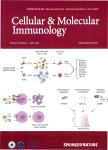Response of BALB/c mice to a monovalent influenza A (H1N1) 2009 split vaccine
Response of BALB/c mice to a monovalent influenza A (H1N1) 2009 split vaccine作者机构:Beijing Institute of Microbiology and Epidemiology State Key Laboratory of Pathogen and Biosecurity Beijing China
出 版 物:《Cellular & Molecular Immunology》 (中国免疫学杂志(英文版))
年 卷 期:2010年第7卷第2期
页 面:116-122页
核心收录:
学科分类:090603[农学-临床兽医学] 0710[理学-生物学] 090602[农学-预防兽医学] 1004[医学-公共卫生与预防医学(可授医学、理学学位)] 1002[医学-临床医学] 1001[医学-基础医学(可授医学、理学学位)] 09[农学] 0906[农学-兽医学]
基 金:National Programs for High Technology Research and Development of China, (2006AA02Z450) National Scientific and Technical Supporting Program of China, (2009CB522102)
主 题:BALB/c mice influenza influenza A (H1N1) split vaccine
摘 要:The novel influenza A (H1N1) 2009 virus has emerged to cause the first pandemic of the twenty-first century. Disease outbreaks caused by the influenza A (H 1N 1) virus have prompted concerns about the potential for a pandemic and have driven the development of vaccines against this subtype of influenza A. In this study, we developed a monovalent influenza A (H 1N 1) split vaccine and evaluated its effects in BALB/c mice. Mice were immunized subcutaneously with 2 doses of the vaccine containing hemagglutinin (HA) alone or HA plus an aluminum hydroxide (AI(OH)3) adjuvant. Immunization with varying doses of HA (3.75, 7.5, 15, 30, 45 or 60μg) was performed to induce the production of neutralizing antibodies. The vaccine elicited strong hemagglutination inhibition (HI) and microneutralization, and addition of the adjuvant augmented the antibody response. A preliminary safety evaluation showed that the vaccine was not toxic at large doses (0.5 ml containing 60 μg HA+600 μg AI(OH)3 or 60 μg HA). Moreover, the vaccine was found to be safe at a dose of 120 μg HA+ 1200 μg AI(OH)3 or 120 μg HA in 1.0 ml in rats. In conclusion; the present study provides support for the clinical evaluation of influenza A (H1N1) vaccination as a public health intervention to mitigate a possible pandemic. Additionally, our findings support the further evaluation of the vaccine used in this study in primates or humans.



